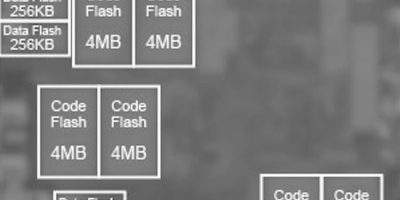Renesas introduces new flash memory for vehicles
Believed to be the largest capacity embedded flash memory available on a microcontroller, Renesas Electronics has presented a 24Mbyte flash memory at the Symposia on VLSI Technology and Circuits in Kyoto, Japan.
The flash memory also offers over-the-air (OTA) support for automotive microcontrollers. Based on next-generation 28nm process technology, it achieves 24Mbyte capacity of embedded flash memory and reaches 240MHz random access read speeds, the industry’s fastest for embedded flash memory, claims Renesas. The technology also achieves low noise write operations when performing OTA wireless software updates, and high-speed and robust operation for OTA software updates.
Technologies used in car systems, such as autonomous driving and electric drive, demand larger embedded flash memory capacities in the microcontrollers due to the increasing scale of the control software. The introduction of OTA technology accelerates the demand for larger capacities to assure adequate storage area for updated programs, points out Renesas. It is necessary to assure real-time performance for adding functions such as functional safety, which makes faster random access read times from the flash memory highly desirable.
High-speed, high-reliability SG-MONOS (metal-oxide-nitride-oxide-silicon) technology is used for the embedded flash memory. The memory cell size has been reduced by more than 15 per cent, using the 28nm process to less than 0.045 microns². In addition to the 24Mbyte of code storage flash memory, Renesas has also included 1Mbyte of data storage flash memory in the test chip for parameters and other data.
Word line division is an effective method for increasing the speed of random access reads in embedded flash memory. However, this division increases the number of word line drivers and causes reliability degradation due to time-dependent dielectric breakdown (TDDB) of the transistors included in those drivers and word line supply voltage drops due to increased leakage current. Renesas resolved these issues using word line driver stress mitigation and distributed word line supply voltage drivers and has verified 240MHz high speed random access, over a wide temperature range (junction temperatures from -40 to 170 degrees C).
By changing the write current applied to each memory cell between initial operation and later operation when programming the flash memory, Renesas has reduced the peak current consumption from the external power supply (Vcc) by 55 per cent without reducing the throughput compared to earlier Renesas devices. This suppresses the adverse influence of supply voltage noise on the microntroller during OTA operations when the car is running. Renesas has also applied the idea of varying the write current to high-speed write mode, in which the number of simultaneously programmed cells is increased. As a result, the new device achieves high-speed programming at 6.5Mbytes per second in this mode. This makes it possible to suppress the increased test times associated with the large memory capacity.




